ACCM 4600 Case Study: Corporate Failure of Dick Smith Holdings
VerifiedAdded on 2023/01/17
|17
|4627
|62
Case Study
AI Summary
This case study analyzes the corporate failure of Dick Smith Holdings, an Australian retail chain. It examines the company's strategic errors, including neglecting market demand and overbuying inventory, which led to high debt and obsolete stock. The report details accounting practices, such as manipulating sales figures and overvaluing inventory, and governance issues, including conflicts of interest and a lack of independent oversight. It also explores the impact of the company's expansion plans and its failure to adapt to the changing consumer electronics market. The study highlights the importance of strong corporate governance, transparent accounting, and effective inventory management, offering lessons for other companies to avoid similar failures. The report concludes with recommendations based on the analysis.
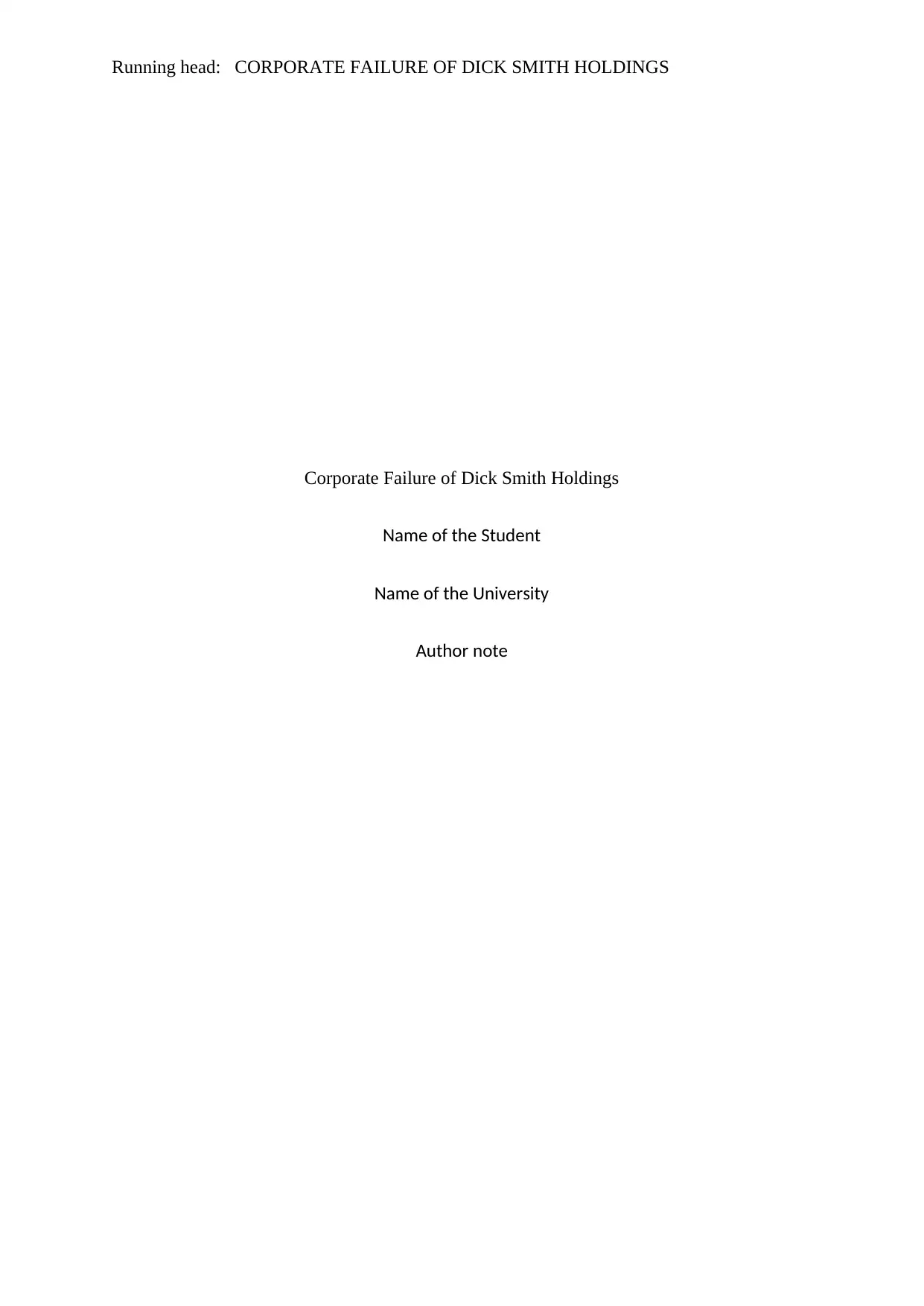
Running head: CORPORATE FAILURE OF DICK SMITH HOLDINGS
Corporate Failure of Dick Smith Holdings
Name of the Student
Name of the University
Author note
Corporate Failure of Dick Smith Holdings
Name of the Student
Name of the University
Author note
Paraphrase This Document
Need a fresh take? Get an instant paraphrase of this document with our AI Paraphraser
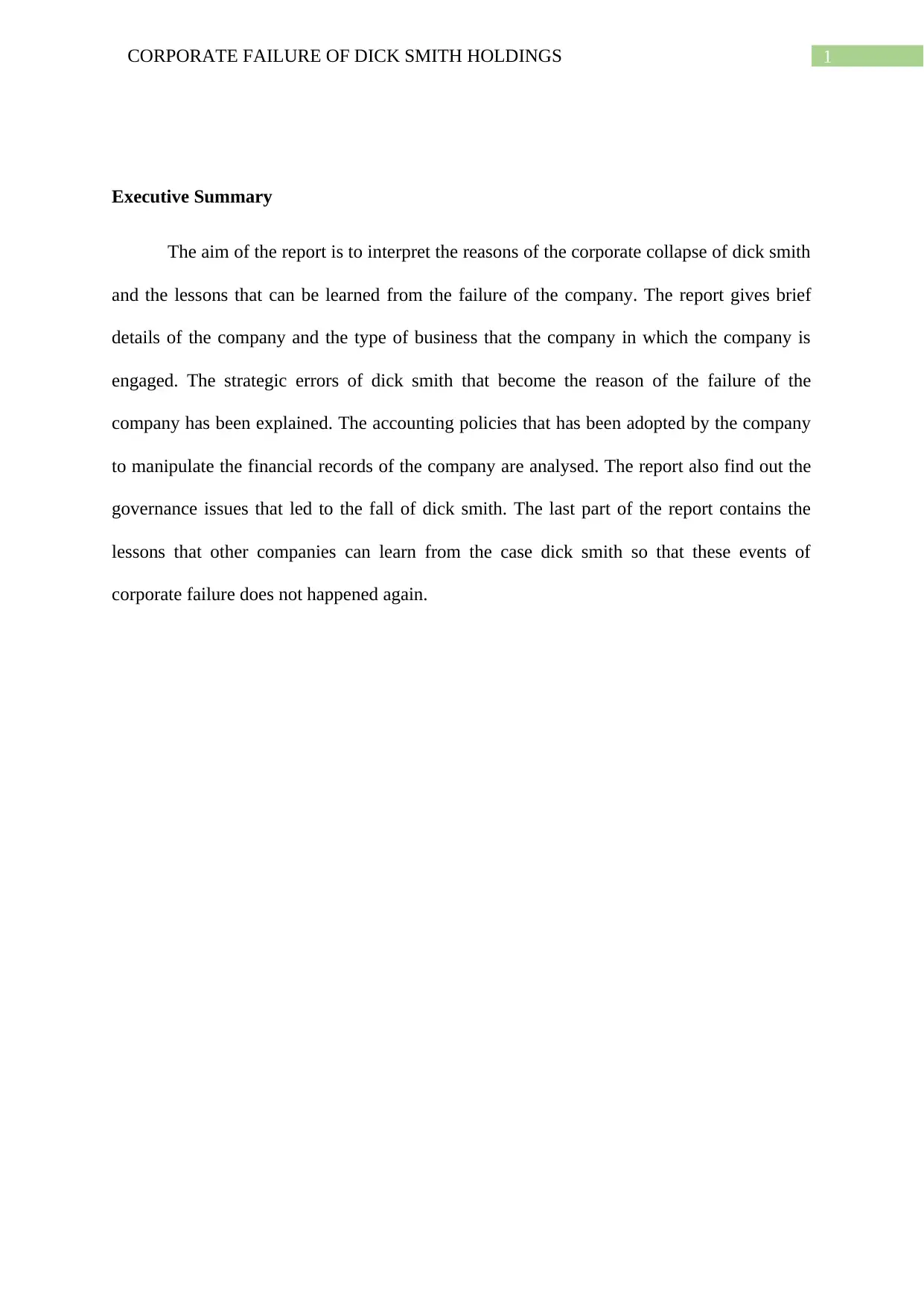
1CORPORATE FAILURE OF DICK SMITH HOLDINGS
Executive Summary
The aim of the report is to interpret the reasons of the corporate collapse of dick smith
and the lessons that can be learned from the failure of the company. The report gives brief
details of the company and the type of business that the company in which the company is
engaged. The strategic errors of dick smith that become the reason of the failure of the
company has been explained. The accounting policies that has been adopted by the company
to manipulate the financial records of the company are analysed. The report also find out the
governance issues that led to the fall of dick smith. The last part of the report contains the
lessons that other companies can learn from the case dick smith so that these events of
corporate failure does not happened again.
Executive Summary
The aim of the report is to interpret the reasons of the corporate collapse of dick smith
and the lessons that can be learned from the failure of the company. The report gives brief
details of the company and the type of business that the company in which the company is
engaged. The strategic errors of dick smith that become the reason of the failure of the
company has been explained. The accounting policies that has been adopted by the company
to manipulate the financial records of the company are analysed. The report also find out the
governance issues that led to the fall of dick smith. The last part of the report contains the
lessons that other companies can learn from the case dick smith so that these events of
corporate failure does not happened again.
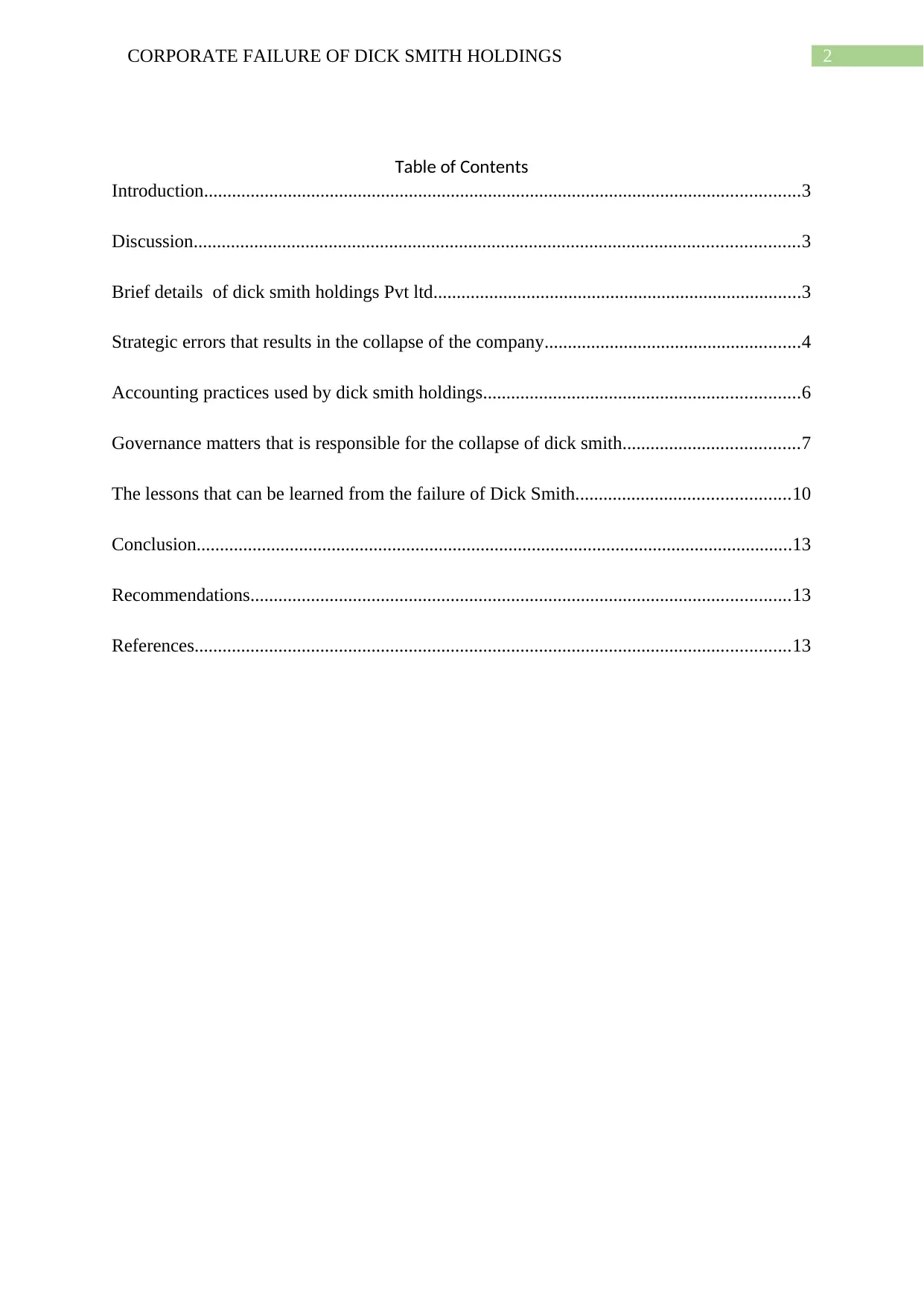
2CORPORATE FAILURE OF DICK SMITH HOLDINGS
Table of Contents
Introduction................................................................................................................................3
Discussion..................................................................................................................................3
Brief details of dick smith holdings Pvt ltd...............................................................................3
Strategic errors that results in the collapse of the company.......................................................4
Accounting practices used by dick smith holdings....................................................................6
Governance matters that is responsible for the collapse of dick smith......................................7
The lessons that can be learned from the failure of Dick Smith..............................................10
Conclusion................................................................................................................................13
Recommendations....................................................................................................................13
References................................................................................................................................13
Table of Contents
Introduction................................................................................................................................3
Discussion..................................................................................................................................3
Brief details of dick smith holdings Pvt ltd...............................................................................3
Strategic errors that results in the collapse of the company.......................................................4
Accounting practices used by dick smith holdings....................................................................6
Governance matters that is responsible for the collapse of dick smith......................................7
The lessons that can be learned from the failure of Dick Smith..............................................10
Conclusion................................................................................................................................13
Recommendations....................................................................................................................13
References................................................................................................................................13
⊘ This is a preview!⊘
Do you want full access?
Subscribe today to unlock all pages.

Trusted by 1+ million students worldwide
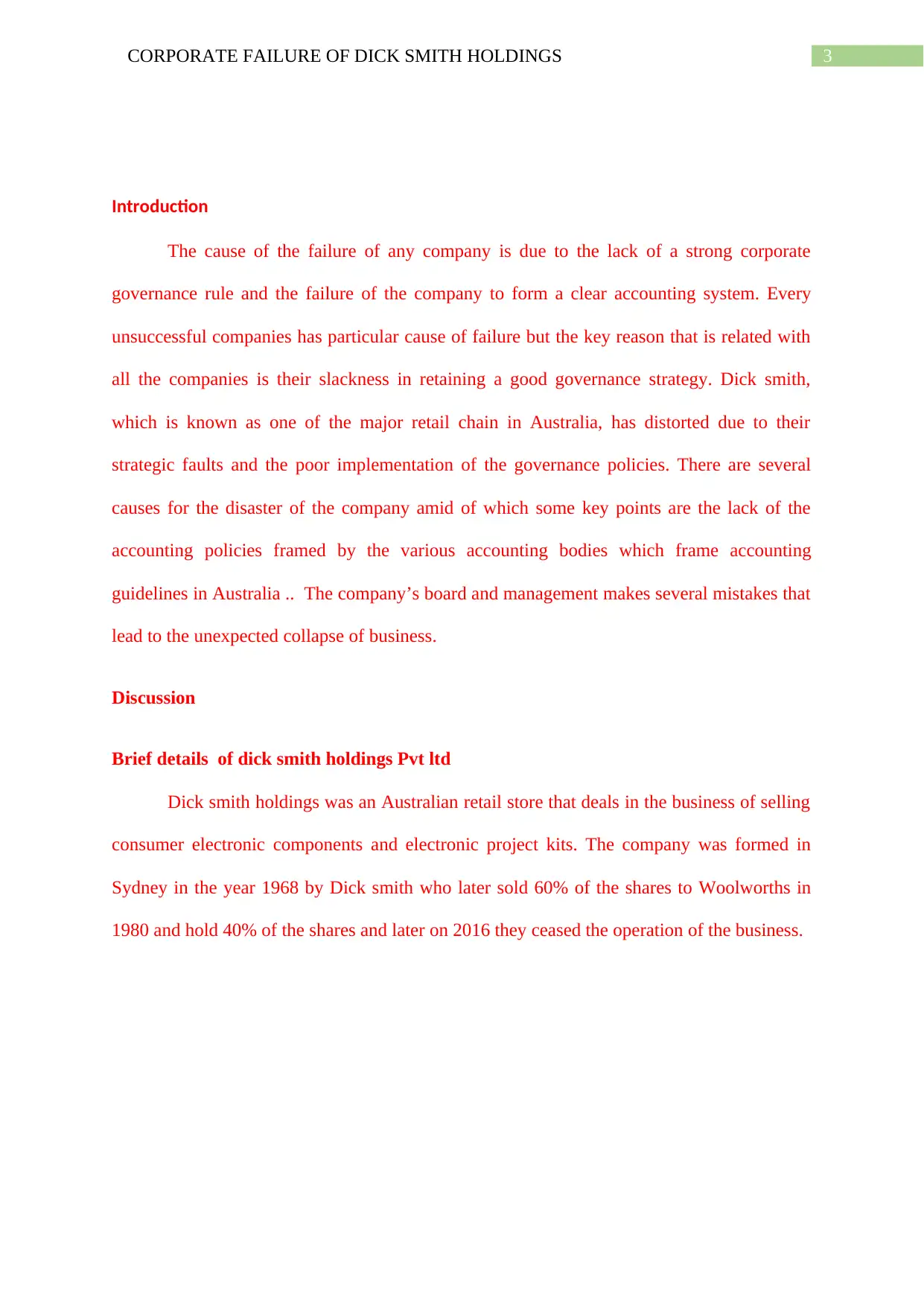
3CORPORATE FAILURE OF DICK SMITH HOLDINGS
Introduction
The cause of the failure of any company is due to the lack of a strong corporate
governance rule and the failure of the company to form a clear accounting system. Every
unsuccessful companies has particular cause of failure but the key reason that is related with
all the companies is their slackness in retaining a good governance strategy. Dick smith,
which is known as one of the major retail chain in Australia, has distorted due to their
strategic faults and the poor implementation of the governance policies. There are several
causes for the disaster of the company amid of which some key points are the lack of the
accounting policies framed by the various accounting bodies which frame accounting
guidelines in Australia .. The company’s board and management makes several mistakes that
lead to the unexpected collapse of business.
Discussion
Brief details of dick smith holdings Pvt ltd
Dick smith holdings was an Australian retail store that deals in the business of selling
consumer electronic components and electronic project kits. The company was formed in
Sydney in the year 1968 by Dick smith who later sold 60% of the shares to Woolworths in
1980 and hold 40% of the shares and later on 2016 they ceased the operation of the business.
Introduction
The cause of the failure of any company is due to the lack of a strong corporate
governance rule and the failure of the company to form a clear accounting system. Every
unsuccessful companies has particular cause of failure but the key reason that is related with
all the companies is their slackness in retaining a good governance strategy. Dick smith,
which is known as one of the major retail chain in Australia, has distorted due to their
strategic faults and the poor implementation of the governance policies. There are several
causes for the disaster of the company amid of which some key points are the lack of the
accounting policies framed by the various accounting bodies which frame accounting
guidelines in Australia .. The company’s board and management makes several mistakes that
lead to the unexpected collapse of business.
Discussion
Brief details of dick smith holdings Pvt ltd
Dick smith holdings was an Australian retail store that deals in the business of selling
consumer electronic components and electronic project kits. The company was formed in
Sydney in the year 1968 by Dick smith who later sold 60% of the shares to Woolworths in
1980 and hold 40% of the shares and later on 2016 they ceased the operation of the business.
Paraphrase This Document
Need a fresh take? Get an instant paraphrase of this document with our AI Paraphraser
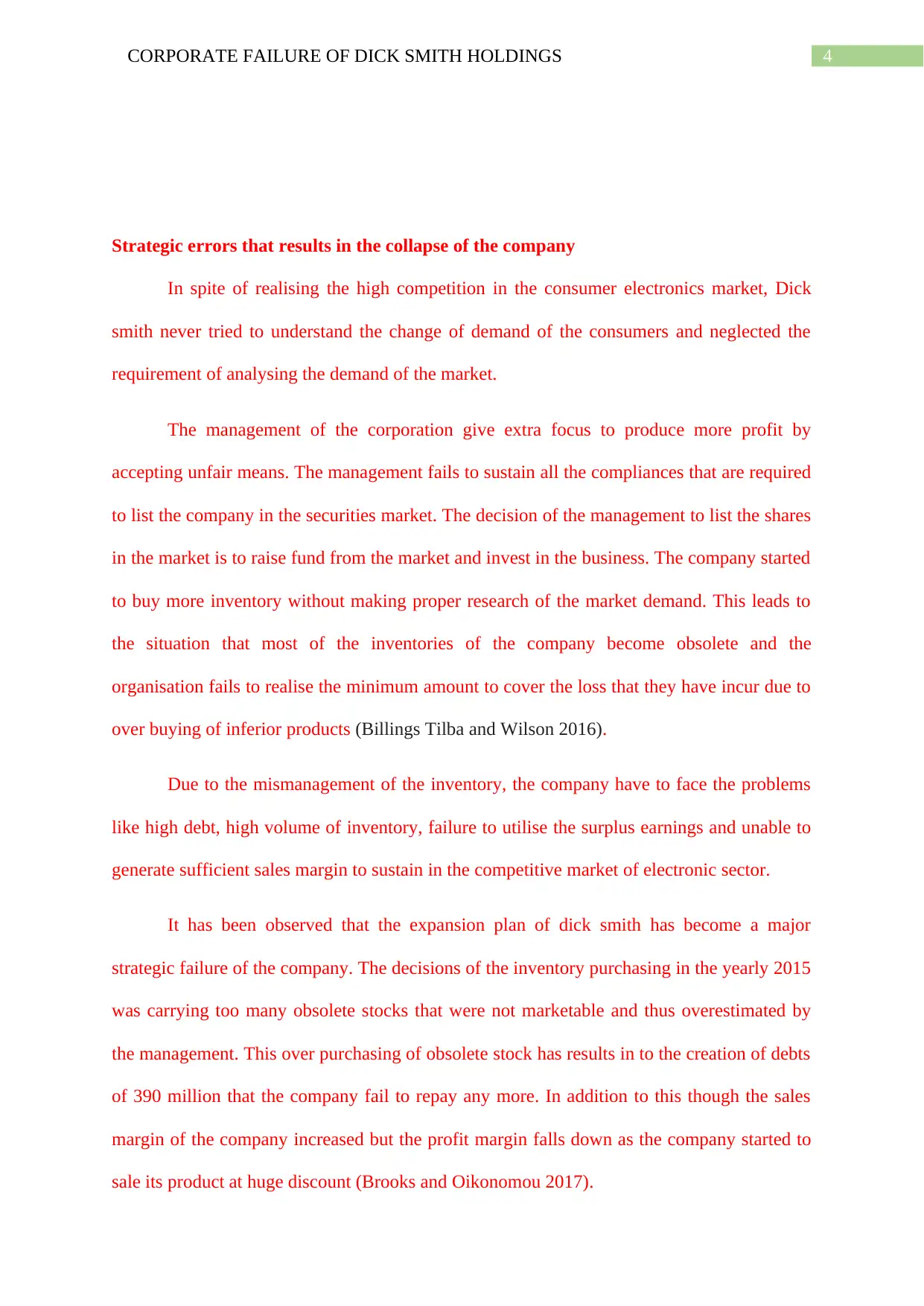
4CORPORATE FAILURE OF DICK SMITH HOLDINGS
Strategic errors that results in the collapse of the company
In spite of realising the high competition in the consumer electronics market, Dick
smith never tried to understand the change of demand of the consumers and neglected the
requirement of analysing the demand of the market.
The management of the corporation give extra focus to produce more profit by
accepting unfair means. The management fails to sustain all the compliances that are required
to list the company in the securities market. The decision of the management to list the shares
in the market is to raise fund from the market and invest in the business. The company started
to buy more inventory without making proper research of the market demand. This leads to
the situation that most of the inventories of the company become obsolete and the
organisation fails to realise the minimum amount to cover the loss that they have incur due to
over buying of inferior products (Billings Tilba and Wilson 2016).
Due to the mismanagement of the inventory, the company have to face the problems
like high debt, high volume of inventory, failure to utilise the surplus earnings and unable to
generate sufficient sales margin to sustain in the competitive market of electronic sector.
It has been observed that the expansion plan of dick smith has become a major
strategic failure of the company. The decisions of the inventory purchasing in the yearly 2015
was carrying too many obsolete stocks that were not marketable and thus overestimated by
the management. This over purchasing of obsolete stock has results in to the creation of debts
of 390 million that the company fail to repay any more. In addition to this though the sales
margin of the company increased but the profit margin falls down as the company started to
sale its product at huge discount (Brooks and Oikonomou 2017).
Strategic errors that results in the collapse of the company
In spite of realising the high competition in the consumer electronics market, Dick
smith never tried to understand the change of demand of the consumers and neglected the
requirement of analysing the demand of the market.
The management of the corporation give extra focus to produce more profit by
accepting unfair means. The management fails to sustain all the compliances that are required
to list the company in the securities market. The decision of the management to list the shares
in the market is to raise fund from the market and invest in the business. The company started
to buy more inventory without making proper research of the market demand. This leads to
the situation that most of the inventories of the company become obsolete and the
organisation fails to realise the minimum amount to cover the loss that they have incur due to
over buying of inferior products (Billings Tilba and Wilson 2016).
Due to the mismanagement of the inventory, the company have to face the problems
like high debt, high volume of inventory, failure to utilise the surplus earnings and unable to
generate sufficient sales margin to sustain in the competitive market of electronic sector.
It has been observed that the expansion plan of dick smith has become a major
strategic failure of the company. The decisions of the inventory purchasing in the yearly 2015
was carrying too many obsolete stocks that were not marketable and thus overestimated by
the management. This over purchasing of obsolete stock has results in to the creation of debts
of 390 million that the company fail to repay any more. In addition to this though the sales
margin of the company increased but the profit margin falls down as the company started to
sale its product at huge discount (Brooks and Oikonomou 2017).
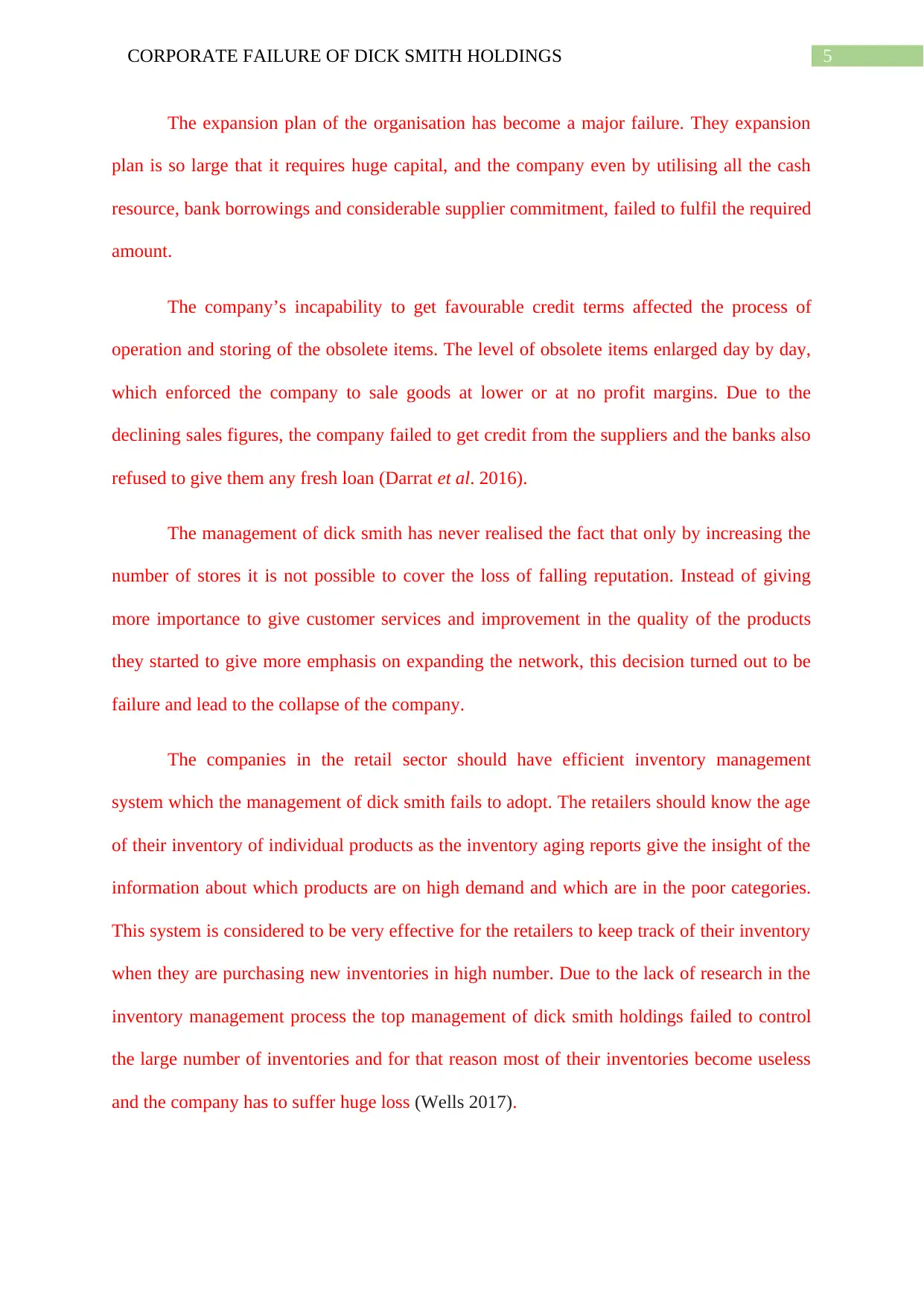
5CORPORATE FAILURE OF DICK SMITH HOLDINGS
The expansion plan of the organisation has become a major failure. They expansion
plan is so large that it requires huge capital, and the company even by utilising all the cash
resource, bank borrowings and considerable supplier commitment, failed to fulfil the required
amount.
The company’s incapability to get favourable credit terms affected the process of
operation and storing of the obsolete items. The level of obsolete items enlarged day by day,
which enforced the company to sale goods at lower or at no profit margins. Due to the
declining sales figures, the company failed to get credit from the suppliers and the banks also
refused to give them any fresh loan (Darrat et al. 2016).
The management of dick smith has never realised the fact that only by increasing the
number of stores it is not possible to cover the loss of falling reputation. Instead of giving
more importance to give customer services and improvement in the quality of the products
they started to give more emphasis on expanding the network, this decision turned out to be
failure and lead to the collapse of the company.
The companies in the retail sector should have efficient inventory management
system which the management of dick smith fails to adopt. The retailers should know the age
of their inventory of individual products as the inventory aging reports give the insight of the
information about which products are on high demand and which are in the poor categories.
This system is considered to be very effective for the retailers to keep track of their inventory
when they are purchasing new inventories in high number. Due to the lack of research in the
inventory management process the top management of dick smith holdings failed to control
the large number of inventories and for that reason most of their inventories become useless
and the company has to suffer huge loss (Wells 2017).
The expansion plan of the organisation has become a major failure. They expansion
plan is so large that it requires huge capital, and the company even by utilising all the cash
resource, bank borrowings and considerable supplier commitment, failed to fulfil the required
amount.
The company’s incapability to get favourable credit terms affected the process of
operation and storing of the obsolete items. The level of obsolete items enlarged day by day,
which enforced the company to sale goods at lower or at no profit margins. Due to the
declining sales figures, the company failed to get credit from the suppliers and the banks also
refused to give them any fresh loan (Darrat et al. 2016).
The management of dick smith has never realised the fact that only by increasing the
number of stores it is not possible to cover the loss of falling reputation. Instead of giving
more importance to give customer services and improvement in the quality of the products
they started to give more emphasis on expanding the network, this decision turned out to be
failure and lead to the collapse of the company.
The companies in the retail sector should have efficient inventory management
system which the management of dick smith fails to adopt. The retailers should know the age
of their inventory of individual products as the inventory aging reports give the insight of the
information about which products are on high demand and which are in the poor categories.
This system is considered to be very effective for the retailers to keep track of their inventory
when they are purchasing new inventories in high number. Due to the lack of research in the
inventory management process the top management of dick smith holdings failed to control
the large number of inventories and for that reason most of their inventories become useless
and the company has to suffer huge loss (Wells 2017).
⊘ This is a preview!⊘
Do you want full access?
Subscribe today to unlock all pages.

Trusted by 1+ million students worldwide
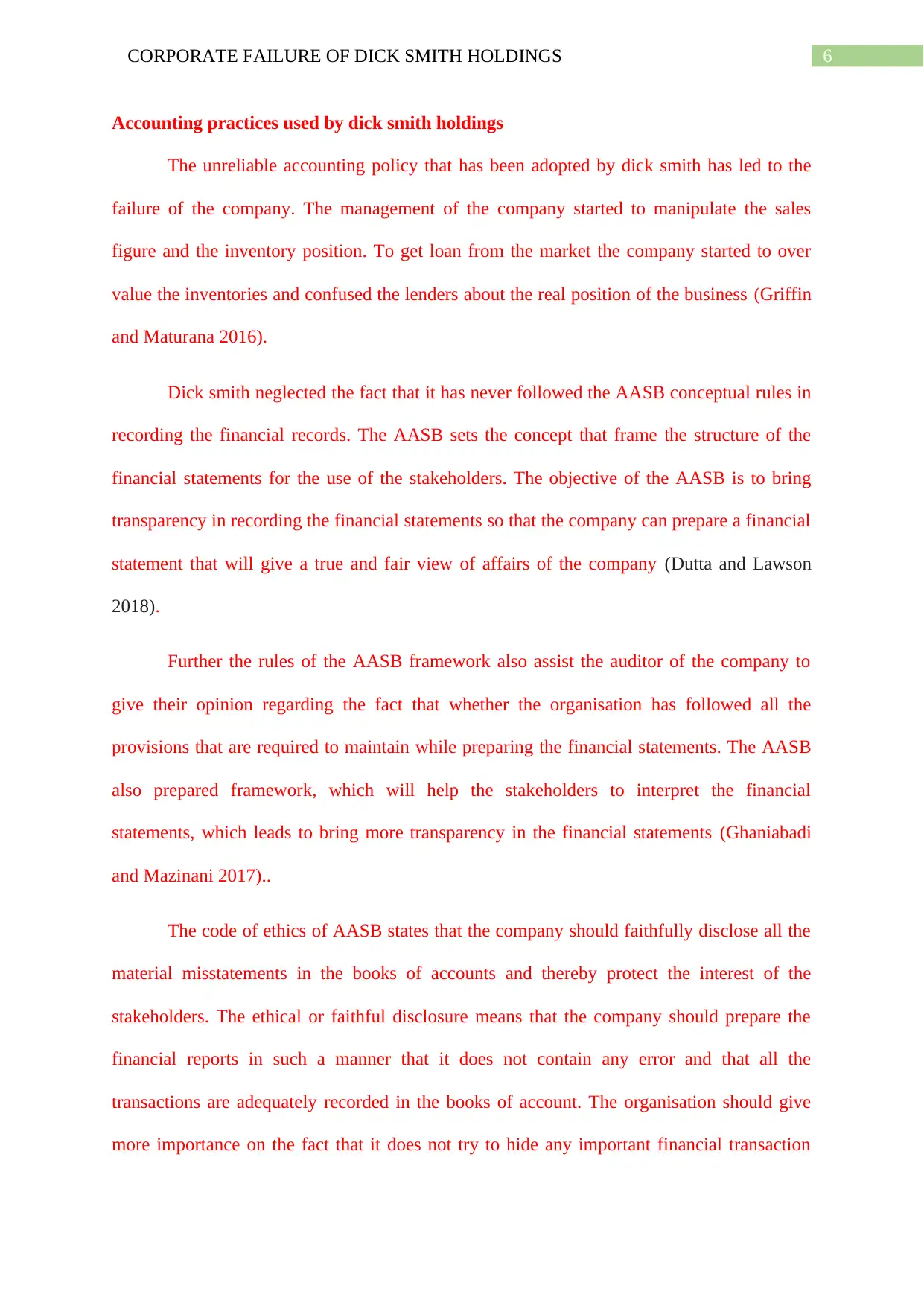
6CORPORATE FAILURE OF DICK SMITH HOLDINGS
Accounting practices used by dick smith holdings
The unreliable accounting policy that has been adopted by dick smith has led to the
failure of the company. The management of the company started to manipulate the sales
figure and the inventory position. To get loan from the market the company started to over
value the inventories and confused the lenders about the real position of the business (Griffin
and Maturana 2016).
Dick smith neglected the fact that it has never followed the AASB conceptual rules in
recording the financial records. The AASB sets the concept that frame the structure of the
financial statements for the use of the stakeholders. The objective of the AASB is to bring
transparency in recording the financial statements so that the company can prepare a financial
statement that will give a true and fair view of affairs of the company (Dutta and Lawson
2018).
Further the rules of the AASB framework also assist the auditor of the company to
give their opinion regarding the fact that whether the organisation has followed all the
provisions that are required to maintain while preparing the financial statements. The AASB
also prepared framework, which will help the stakeholders to interpret the financial
statements, which leads to bring more transparency in the financial statements (Ghaniabadi
and Mazinani 2017)..
The code of ethics of AASB states that the company should faithfully disclose all the
material misstatements in the books of accounts and thereby protect the interest of the
stakeholders. The ethical or faithful disclosure means that the company should prepare the
financial reports in such a manner that it does not contain any error and that all the
transactions are adequately recorded in the books of account. The organisation should give
more importance on the fact that it does not try to hide any important financial transaction
Accounting practices used by dick smith holdings
The unreliable accounting policy that has been adopted by dick smith has led to the
failure of the company. The management of the company started to manipulate the sales
figure and the inventory position. To get loan from the market the company started to over
value the inventories and confused the lenders about the real position of the business (Griffin
and Maturana 2016).
Dick smith neglected the fact that it has never followed the AASB conceptual rules in
recording the financial records. The AASB sets the concept that frame the structure of the
financial statements for the use of the stakeholders. The objective of the AASB is to bring
transparency in recording the financial statements so that the company can prepare a financial
statement that will give a true and fair view of affairs of the company (Dutta and Lawson
2018).
Further the rules of the AASB framework also assist the auditor of the company to
give their opinion regarding the fact that whether the organisation has followed all the
provisions that are required to maintain while preparing the financial statements. The AASB
also prepared framework, which will help the stakeholders to interpret the financial
statements, which leads to bring more transparency in the financial statements (Ghaniabadi
and Mazinani 2017)..
The code of ethics of AASB states that the company should faithfully disclose all the
material misstatements in the books of accounts and thereby protect the interest of the
stakeholders. The ethical or faithful disclosure means that the company should prepare the
financial reports in such a manner that it does not contain any error and that all the
transactions are adequately recorded in the books of account. The organisation should give
more importance on the fact that it does not try to hide any important financial transaction
Paraphrase This Document
Need a fresh take? Get an instant paraphrase of this document with our AI Paraphraser
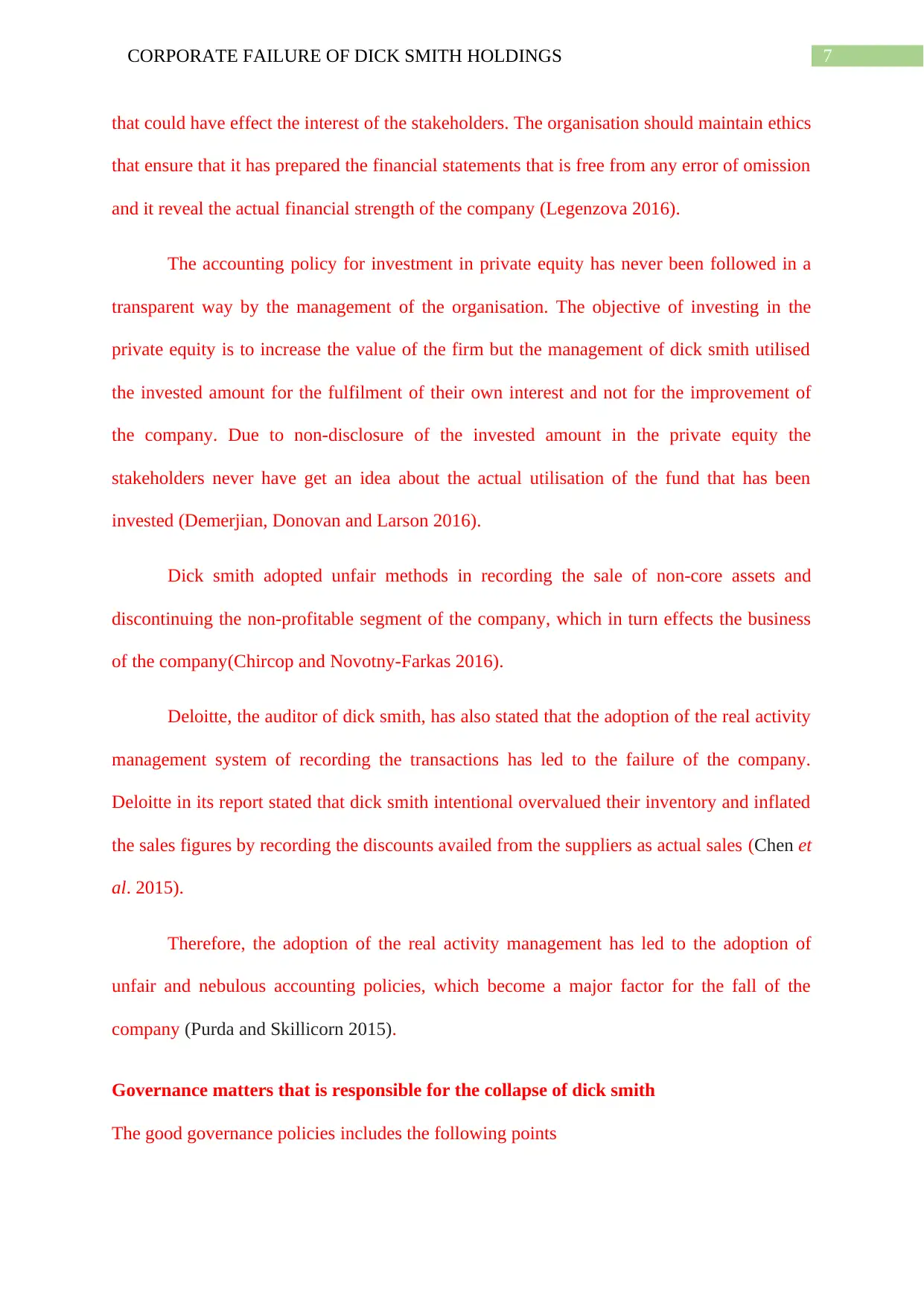
7CORPORATE FAILURE OF DICK SMITH HOLDINGS
that could have effect the interest of the stakeholders. The organisation should maintain ethics
that ensure that it has prepared the financial statements that is free from any error of omission
and it reveal the actual financial strength of the company (Legenzova 2016).
The accounting policy for investment in private equity has never been followed in a
transparent way by the management of the organisation. The objective of investing in the
private equity is to increase the value of the firm but the management of dick smith utilised
the invested amount for the fulfilment of their own interest and not for the improvement of
the company. Due to non-disclosure of the invested amount in the private equity the
stakeholders never have get an idea about the actual utilisation of the fund that has been
invested (Demerjian, Donovan and Larson 2016).
Dick smith adopted unfair methods in recording the sale of non-core assets and
discontinuing the non-profitable segment of the company, which in turn effects the business
of the company(Chircop and Novotny-Farkas 2016).
Deloitte, the auditor of dick smith, has also stated that the adoption of the real activity
management system of recording the transactions has led to the failure of the company.
Deloitte in its report stated that dick smith intentional overvalued their inventory and inflated
the sales figures by recording the discounts availed from the suppliers as actual sales (Chen et
al. 2015).
Therefore, the adoption of the real activity management has led to the adoption of
unfair and nebulous accounting policies, which become a major factor for the fall of the
company (Purda and Skillicorn 2015).
Governance matters that is responsible for the collapse of dick smith
The good governance policies includes the following points
that could have effect the interest of the stakeholders. The organisation should maintain ethics
that ensure that it has prepared the financial statements that is free from any error of omission
and it reveal the actual financial strength of the company (Legenzova 2016).
The accounting policy for investment in private equity has never been followed in a
transparent way by the management of the organisation. The objective of investing in the
private equity is to increase the value of the firm but the management of dick smith utilised
the invested amount for the fulfilment of their own interest and not for the improvement of
the company. Due to non-disclosure of the invested amount in the private equity the
stakeholders never have get an idea about the actual utilisation of the fund that has been
invested (Demerjian, Donovan and Larson 2016).
Dick smith adopted unfair methods in recording the sale of non-core assets and
discontinuing the non-profitable segment of the company, which in turn effects the business
of the company(Chircop and Novotny-Farkas 2016).
Deloitte, the auditor of dick smith, has also stated that the adoption of the real activity
management system of recording the transactions has led to the failure of the company.
Deloitte in its report stated that dick smith intentional overvalued their inventory and inflated
the sales figures by recording the discounts availed from the suppliers as actual sales (Chen et
al. 2015).
Therefore, the adoption of the real activity management has led to the adoption of
unfair and nebulous accounting policies, which become a major factor for the fall of the
company (Purda and Skillicorn 2015).
Governance matters that is responsible for the collapse of dick smith
The good governance policies includes the following points
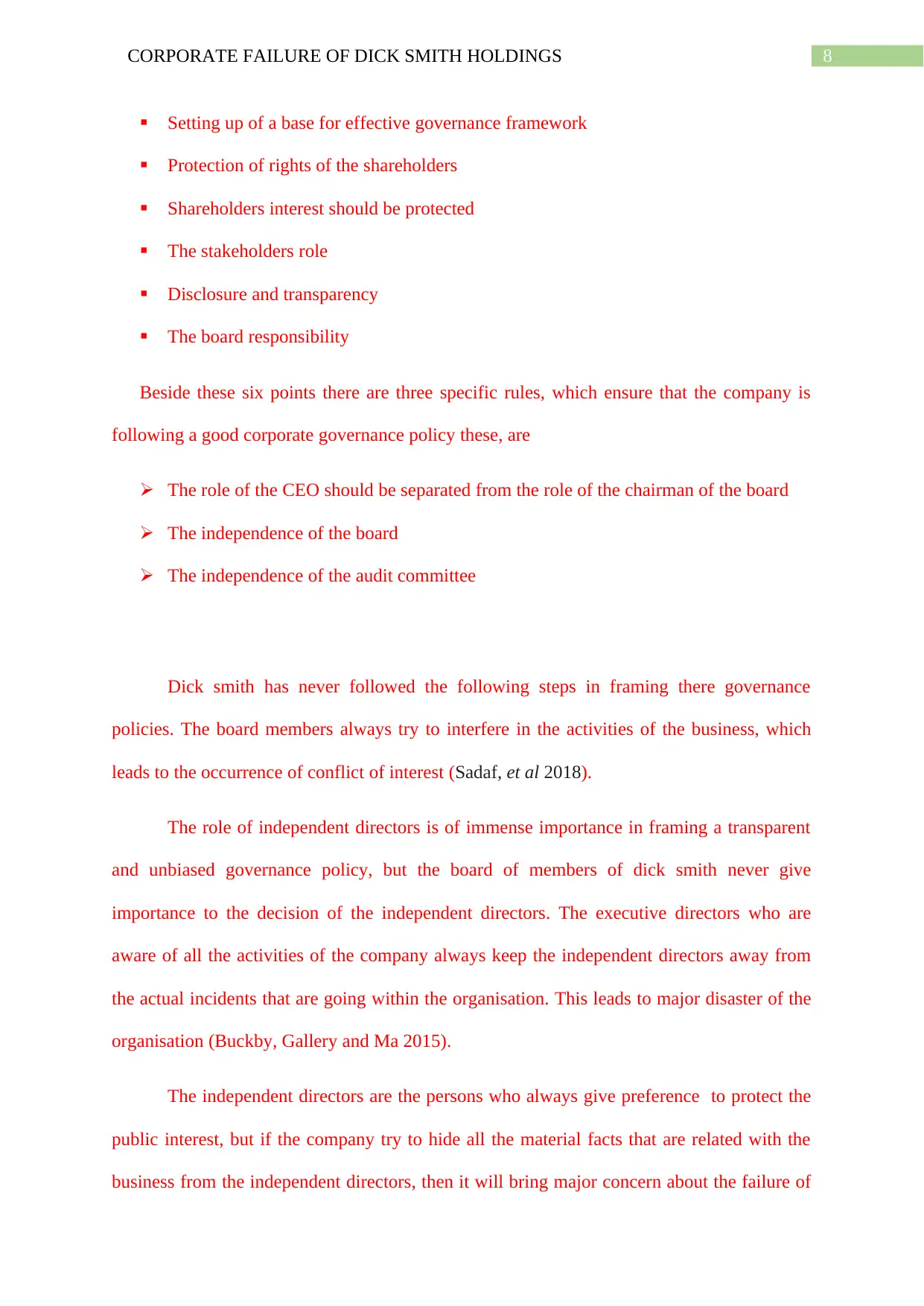
8CORPORATE FAILURE OF DICK SMITH HOLDINGS
Setting up of a base for effective governance framework
Protection of rights of the shareholders
Shareholders interest should be protected
The stakeholders role
Disclosure and transparency
The board responsibility
Beside these six points there are three specific rules, which ensure that the company is
following a good corporate governance policy these, are
The role of the CEO should be separated from the role of the chairman of the board
The independence of the board
The independence of the audit committee
Dick smith has never followed the following steps in framing there governance
policies. The board members always try to interfere in the activities of the business, which
leads to the occurrence of conflict of interest (Sadaf, et al 2018).
The role of independent directors is of immense importance in framing a transparent
and unbiased governance policy, but the board of members of dick smith never give
importance to the decision of the independent directors. The executive directors who are
aware of all the activities of the company always keep the independent directors away from
the actual incidents that are going within the organisation. This leads to major disaster of the
organisation (Buckby, Gallery and Ma 2015).
The independent directors are the persons who always give preference to protect the
public interest, but if the company try to hide all the material facts that are related with the
business from the independent directors, then it will bring major concern about the failure of
Setting up of a base for effective governance framework
Protection of rights of the shareholders
Shareholders interest should be protected
The stakeholders role
Disclosure and transparency
The board responsibility
Beside these six points there are three specific rules, which ensure that the company is
following a good corporate governance policy these, are
The role of the CEO should be separated from the role of the chairman of the board
The independence of the board
The independence of the audit committee
Dick smith has never followed the following steps in framing there governance
policies. The board members always try to interfere in the activities of the business, which
leads to the occurrence of conflict of interest (Sadaf, et al 2018).
The role of independent directors is of immense importance in framing a transparent
and unbiased governance policy, but the board of members of dick smith never give
importance to the decision of the independent directors. The executive directors who are
aware of all the activities of the company always keep the independent directors away from
the actual incidents that are going within the organisation. This leads to major disaster of the
organisation (Buckby, Gallery and Ma 2015).
The independent directors are the persons who always give preference to protect the
public interest, but if the company try to hide all the material facts that are related with the
business from the independent directors, then it will bring major concern about the failure of
⊘ This is a preview!⊘
Do you want full access?
Subscribe today to unlock all pages.

Trusted by 1+ million students worldwide
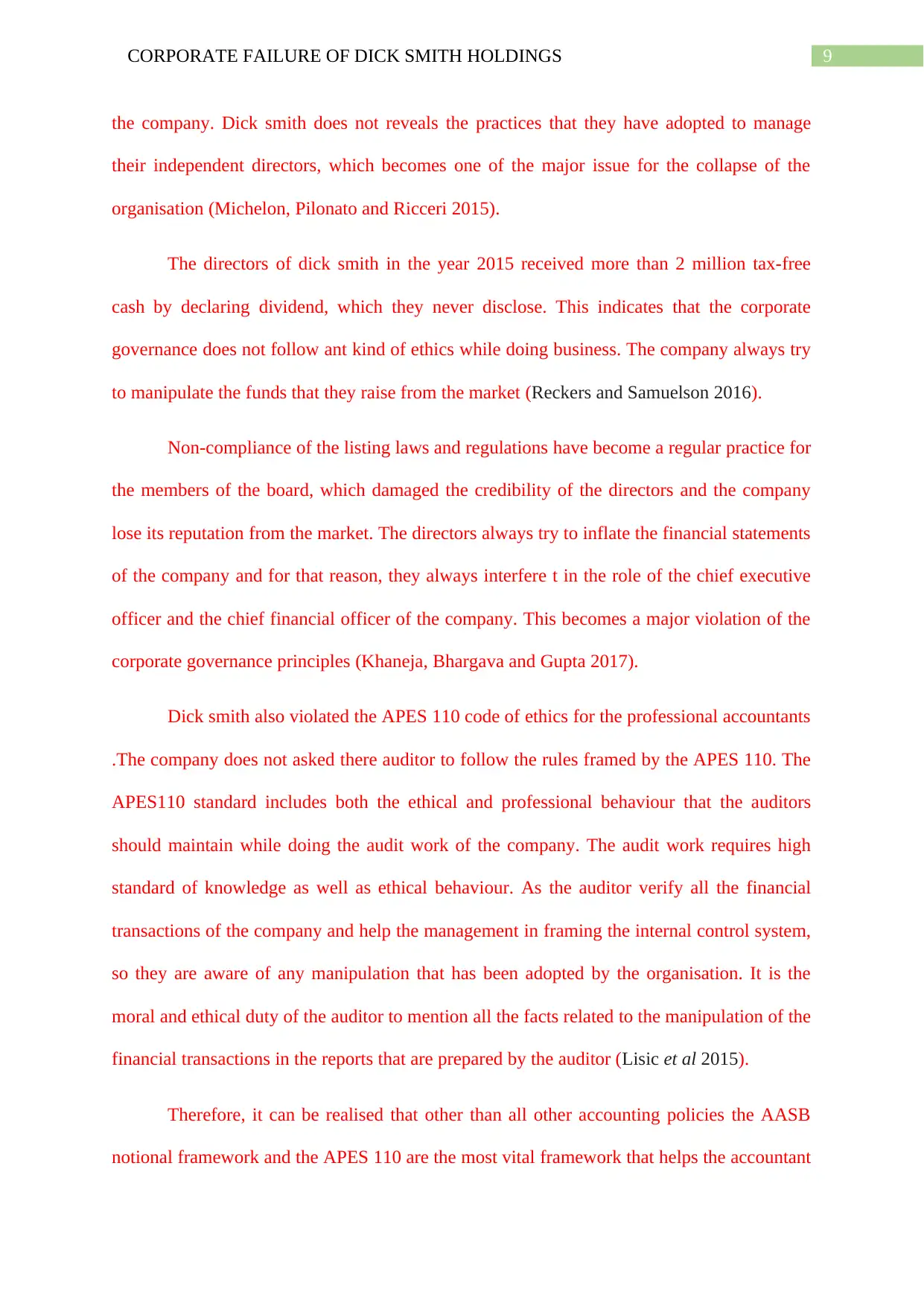
9CORPORATE FAILURE OF DICK SMITH HOLDINGS
the company. Dick smith does not reveals the practices that they have adopted to manage
their independent directors, which becomes one of the major issue for the collapse of the
organisation (Michelon, Pilonato and Ricceri 2015).
The directors of dick smith in the year 2015 received more than 2 million tax-free
cash by declaring dividend, which they never disclose. This indicates that the corporate
governance does not follow ant kind of ethics while doing business. The company always try
to manipulate the funds that they raise from the market (Reckers and Samuelson 2016).
Non-compliance of the listing laws and regulations have become a regular practice for
the members of the board, which damaged the credibility of the directors and the company
lose its reputation from the market. The directors always try to inflate the financial statements
of the company and for that reason, they always interfere t in the role of the chief executive
officer and the chief financial officer of the company. This becomes a major violation of the
corporate governance principles (Khaneja, Bhargava and Gupta 2017).
Dick smith also violated the APES 110 code of ethics for the professional accountants
.The company does not asked there auditor to follow the rules framed by the APES 110. The
APES110 standard includes both the ethical and professional behaviour that the auditors
should maintain while doing the audit work of the company. The audit work requires high
standard of knowledge as well as ethical behaviour. As the auditor verify all the financial
transactions of the company and help the management in framing the internal control system,
so they are aware of any manipulation that has been adopted by the organisation. It is the
moral and ethical duty of the auditor to mention all the facts related to the manipulation of the
financial transactions in the reports that are prepared by the auditor (Lisic et al 2015).
Therefore, it can be realised that other than all other accounting policies the AASB
notional framework and the APES 110 are the most vital framework that helps the accountant
the company. Dick smith does not reveals the practices that they have adopted to manage
their independent directors, which becomes one of the major issue for the collapse of the
organisation (Michelon, Pilonato and Ricceri 2015).
The directors of dick smith in the year 2015 received more than 2 million tax-free
cash by declaring dividend, which they never disclose. This indicates that the corporate
governance does not follow ant kind of ethics while doing business. The company always try
to manipulate the funds that they raise from the market (Reckers and Samuelson 2016).
Non-compliance of the listing laws and regulations have become a regular practice for
the members of the board, which damaged the credibility of the directors and the company
lose its reputation from the market. The directors always try to inflate the financial statements
of the company and for that reason, they always interfere t in the role of the chief executive
officer and the chief financial officer of the company. This becomes a major violation of the
corporate governance principles (Khaneja, Bhargava and Gupta 2017).
Dick smith also violated the APES 110 code of ethics for the professional accountants
.The company does not asked there auditor to follow the rules framed by the APES 110. The
APES110 standard includes both the ethical and professional behaviour that the auditors
should maintain while doing the audit work of the company. The audit work requires high
standard of knowledge as well as ethical behaviour. As the auditor verify all the financial
transactions of the company and help the management in framing the internal control system,
so they are aware of any manipulation that has been adopted by the organisation. It is the
moral and ethical duty of the auditor to mention all the facts related to the manipulation of the
financial transactions in the reports that are prepared by the auditor (Lisic et al 2015).
Therefore, it can be realised that other than all other accounting policies the AASB
notional framework and the APES 110 are the most vital framework that helps the accountant
Paraphrase This Document
Need a fresh take? Get an instant paraphrase of this document with our AI Paraphraser
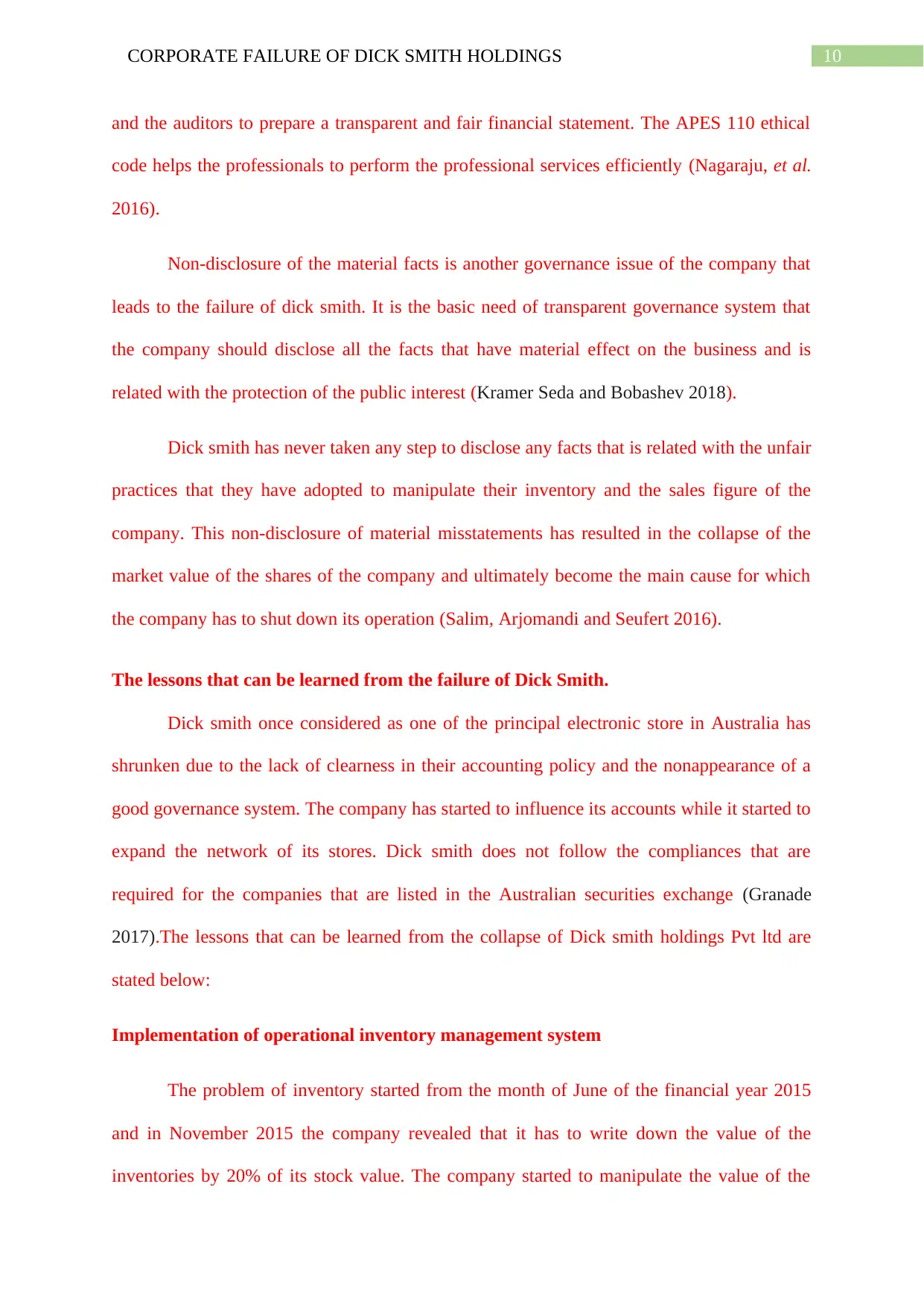
10CORPORATE FAILURE OF DICK SMITH HOLDINGS
and the auditors to prepare a transparent and fair financial statement. The APES 110 ethical
code helps the professionals to perform the professional services efficiently (Nagaraju, et al.
2016).
Non-disclosure of the material facts is another governance issue of the company that
leads to the failure of dick smith. It is the basic need of transparent governance system that
the company should disclose all the facts that have material effect on the business and is
related with the protection of the public interest (Kramer Seda and Bobashev 2018).
Dick smith has never taken any step to disclose any facts that is related with the unfair
practices that they have adopted to manipulate their inventory and the sales figure of the
company. This non-disclosure of material misstatements has resulted in the collapse of the
market value of the shares of the company and ultimately become the main cause for which
the company has to shut down its operation (Salim, Arjomandi and Seufert 2016).
The lessons that can be learned from the failure of Dick Smith.
Dick smith once considered as one of the principal electronic store in Australia has
shrunken due to the lack of clearness in their accounting policy and the nonappearance of a
good governance system. The company has started to influence its accounts while it started to
expand the network of its stores. Dick smith does not follow the compliances that are
required for the companies that are listed in the Australian securities exchange (Granade
2017).The lessons that can be learned from the collapse of Dick smith holdings Pvt ltd are
stated below:
Implementation of operational inventory management system
The problem of inventory started from the month of June of the financial year 2015
and in November 2015 the company revealed that it has to write down the value of the
inventories by 20% of its stock value. The company started to manipulate the value of the
and the auditors to prepare a transparent and fair financial statement. The APES 110 ethical
code helps the professionals to perform the professional services efficiently (Nagaraju, et al.
2016).
Non-disclosure of the material facts is another governance issue of the company that
leads to the failure of dick smith. It is the basic need of transparent governance system that
the company should disclose all the facts that have material effect on the business and is
related with the protection of the public interest (Kramer Seda and Bobashev 2018).
Dick smith has never taken any step to disclose any facts that is related with the unfair
practices that they have adopted to manipulate their inventory and the sales figure of the
company. This non-disclosure of material misstatements has resulted in the collapse of the
market value of the shares of the company and ultimately become the main cause for which
the company has to shut down its operation (Salim, Arjomandi and Seufert 2016).
The lessons that can be learned from the failure of Dick Smith.
Dick smith once considered as one of the principal electronic store in Australia has
shrunken due to the lack of clearness in their accounting policy and the nonappearance of a
good governance system. The company has started to influence its accounts while it started to
expand the network of its stores. Dick smith does not follow the compliances that are
required for the companies that are listed in the Australian securities exchange (Granade
2017).The lessons that can be learned from the collapse of Dick smith holdings Pvt ltd are
stated below:
Implementation of operational inventory management system
The problem of inventory started from the month of June of the financial year 2015
and in November 2015 the company revealed that it has to write down the value of the
inventories by 20% of its stock value. The company started to manipulate the value of the
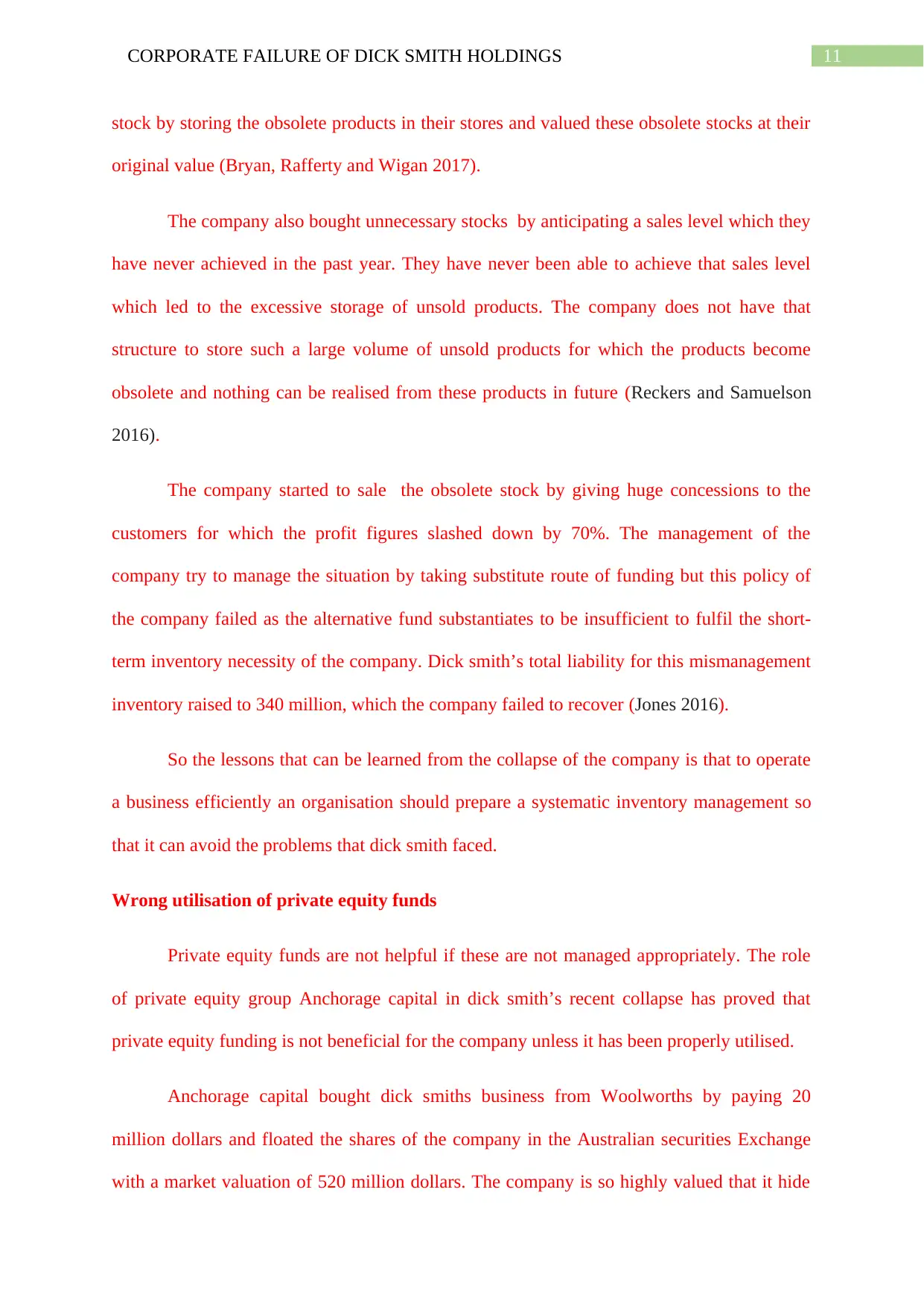
11CORPORATE FAILURE OF DICK SMITH HOLDINGS
stock by storing the obsolete products in their stores and valued these obsolete stocks at their
original value (Bryan, Rafferty and Wigan 2017).
The company also bought unnecessary stocks by anticipating a sales level which they
have never achieved in the past year. They have never been able to achieve that sales level
which led to the excessive storage of unsold products. The company does not have that
structure to store such a large volume of unsold products for which the products become
obsolete and nothing can be realised from these products in future (Reckers and Samuelson
2016).
The company started to sale the obsolete stock by giving huge concessions to the
customers for which the profit figures slashed down by 70%. The management of the
company try to manage the situation by taking substitute route of funding but this policy of
the company failed as the alternative fund substantiates to be insufficient to fulfil the short-
term inventory necessity of the company. Dick smith’s total liability for this mismanagement
inventory raised to 340 million, which the company failed to recover (Jones 2016).
So the lessons that can be learned from the collapse of the company is that to operate
a business efficiently an organisation should prepare a systematic inventory management so
that it can avoid the problems that dick smith faced.
Wrong utilisation of private equity funds
Private equity funds are not helpful if these are not managed appropriately. The role
of private equity group Anchorage capital in dick smith’s recent collapse has proved that
private equity funding is not beneficial for the company unless it has been properly utilised.
Anchorage capital bought dick smiths business from Woolworths by paying 20
million dollars and floated the shares of the company in the Australian securities Exchange
with a market valuation of 520 million dollars. The company is so highly valued that it hide
stock by storing the obsolete products in their stores and valued these obsolete stocks at their
original value (Bryan, Rafferty and Wigan 2017).
The company also bought unnecessary stocks by anticipating a sales level which they
have never achieved in the past year. They have never been able to achieve that sales level
which led to the excessive storage of unsold products. The company does not have that
structure to store such a large volume of unsold products for which the products become
obsolete and nothing can be realised from these products in future (Reckers and Samuelson
2016).
The company started to sale the obsolete stock by giving huge concessions to the
customers for which the profit figures slashed down by 70%. The management of the
company try to manage the situation by taking substitute route of funding but this policy of
the company failed as the alternative fund substantiates to be insufficient to fulfil the short-
term inventory necessity of the company. Dick smith’s total liability for this mismanagement
inventory raised to 340 million, which the company failed to recover (Jones 2016).
So the lessons that can be learned from the collapse of the company is that to operate
a business efficiently an organisation should prepare a systematic inventory management so
that it can avoid the problems that dick smith faced.
Wrong utilisation of private equity funds
Private equity funds are not helpful if these are not managed appropriately. The role
of private equity group Anchorage capital in dick smith’s recent collapse has proved that
private equity funding is not beneficial for the company unless it has been properly utilised.
Anchorage capital bought dick smiths business from Woolworths by paying 20
million dollars and floated the shares of the company in the Australian securities Exchange
with a market valuation of 520 million dollars. The company is so highly valued that it hide
⊘ This is a preview!⊘
Do you want full access?
Subscribe today to unlock all pages.

Trusted by 1+ million students worldwide
1 out of 17
Related Documents
Your All-in-One AI-Powered Toolkit for Academic Success.
+13062052269
info@desklib.com
Available 24*7 on WhatsApp / Email
![[object Object]](/_next/static/media/star-bottom.7253800d.svg)
Unlock your academic potential
Copyright © 2020–2025 A2Z Services. All Rights Reserved. Developed and managed by ZUCOL.





